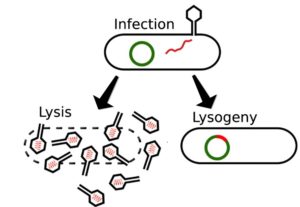

Evidence that virus-infected cells produce a substance that can regulate the lysis-lysogeny decision came from the observation that conditioned medium from Bacillus subtilis infected with the bacteriophage phi3T – prepared so that is was virus and cell free – protects cells from lysis. The protective component is destroyed by digestion with a proteinase and hence is a protein. Conditioned medium not only inhibits cell lysis, but increases lysogeny, measured by integration of viral DNA into the bacterial genome.
Examination of the genome sequence of phage phi3T suggested that a six amino acid peptide, Ser-Ala-Ile-Arg-Gly-Ala, was the component in conditioned medium that regulates the lytic-lysogenic decision. Addition of the synthetic peptide to infected cells decreased lysis. The levels of this peptide increase during each cycle of phage infection of the Bacillus host.
The authors call the communication peptide ‘arbitrium’ from the Latin word meaning ‘decision’. The gene encoding the peptide is aimP.
AimP appears to work by entering the bacterium through a transporter protein and binding a protein in the bacterial cell called AimR. The AimR protein in turn binds a sequence in the bacterial genome called aimX. When AimR is bound by the peptide, it cannot bind aimX and lysogeny occurs. In the absence of peptide, AimR binds aimX and lysis proceeds. The product of the aimX gene appears to be a regulatory RNA, but how it promotes lysis is not known.
Different phages of B. subtilis also encode peptides that regulate the lysis-lysogeny decision in a phage-specific manner.
These findings describe a viral communication system that determines whether a bacterial host is lysed or lysogenized. When viruses initially infect a host, the result is lysis because levels of peptide are low. After several cycles of infection the AimP concentrations increase, and upon entry of the peptide into bacteria they lead to lysogeny.
The authors of this work suggest that the arbitrium system is a way for the virus to sense the amount of previous infections to decide whether lysis or lysogeny should occur. If many previous infections have taken place, the host population could be too low to support lytic replication, hence lysogeny occurs. Because lysogens can divide, the bacterial population can be restored to a level that can sustain virus infection.
Of course, the virus particle cannot sense anything – it is a bacterial protein that binds AimP and another bacterial gene that controls lysis. In other words, the virus-infected cell, not the virus, can sense the amount of previous infections.
It should be straightforward to search the genome sequences of phages that infect other bacteria to determine if such a communication system is widespread. More interesting is whether viruses that infect eukaryotes also have communication systems that guide decisions about lytic versus non-lytic or latent infection.

Pingback: mycology | [Veterinary and Medical Sciences
Pingback: Communication between virus-infected cells – Virology
Pingback: La communication chez les micro-organismes | archivEngines